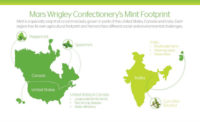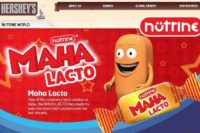On Sept. 8, 2012, The Hershey Co. acquired the outstanding 49% stake in its Indian joint venture with Godrej Group. In doing so, it announced the establishment of Hershey India, a fully owned subsidiary.
Financial details of the deal were not disclosed but under the agreement Hershey assumed $47.6 million in debt from the venture. It will also gain the established brand portfolio, led by the Maha Lacto andNutrine sugar confectionery brands andJumpin and Sofit beverages, as well as two factories located in Chittoor and Mandideep. In 2011, the Godrej Hershey venture reportedly had net sales of $80 million but suffered a net loss.
This major acquisition shows that Hershey is finally looking to move beyond its domestic U.S. market and is seriously investing in its recently reaffirmed, and much needed, international expansion strategy. Targeting one of the most attractive confectionery markets in the world is a positive move, but the assets it recently acquired have a track record of unprofitable operations and eroding market share.
Since its formation in 2007, the joint venture failed to introduce any significant Hershey brands to India other than the company’s eponymous chocolate syrup. As such, Hershey will face major challenges to turn its new subsidiary into a dynamic and profitable organization that can fully leverage its indisputable legacy and brand equity. Moreover, Hershey will have to do this without a local venture partner and in the face of strong competition from leading multinational rivals already active in India’s increasingly lucrative confectionery market.
Positive growth prospects in India
Hershey has chosen wisely in making India one of its primary targets for international expansion. According to Euromonitor International’s latest research, India is currently on track to be the world’s fastest growing confectionery market in 2012. Overall retail sales are expected to increase by 16% in real terms — or nearly $320 million — from 2011, bringing total sales over $2.3 billion. The pace of retail growth is also accelerating, with annual average gains between 2007 and 2012 reaching 12%. This translates into absolute gains topping $1 billion.
Moreover, Indian consumer preferences for confectionery have been changing dramatically over the last five years. In 2007, sugar confectionery was the dominant segment by retail value, totalling $586 million. By contrast, the country’s chocolate confectionery market amounted to $550 million, while gum sales lagged with a relatively paltry $195 million. By the end of 2012, however, India’s chocolate market should surpass $1.2 billion, compared to $750 million for sugar confectionery and just under $390 million for gum.
This transformation is primarily a function of India’s phenomenal economic growth in recent years, and has been driven largely by the expanding middle classes in major Indian cities including Mumbai and Bangalore. According to Euromonitor International’s Countries and Consumers research, average annual disposable income in India increased in real terms from nearly $1,000 per head in 2006 to more than $1,200 in 2011. As spending power steadily rises, especially in cities, increasingly aspirational and sophisticated consumers prefer indulgent and luxurious chocolate to cheap and cheerful sugar confections.
This obviously bodes well for Hershey and its stable of chocolate brands. It can also leverage its international credentials and All-American image to appeal to increasingly affluent and discriminating Indian consumers. However, market consolidation in India’s confectionery market is already high, with multinationals holding a dominant position in terms of retail value share in 2012: Kraft (including its recently acquired Cadbury assets) holds 33%; Perfetti van Melle hovers at 18%; Nestlé a 14% share; and Mars 7%. Local companies ITC Group and Parle Products follow Mars in the rankings, accounting each for 4% of market share.
While small, Ferrero Group represents another potential competitive threat for Hershey. Ferrero currently commands just slightly more than 2% of India’s confectionery market. Albeit a small percentage, this represents a significant improvement on a largely negligible presence as recently as four years ago. Moreover, Ferrero has made its interest in India all too clear, opening a plant 100 kilometers from the city of Pune in October 2011 as part of its mounting focus on emerging markets.
Hershey’s Indian portfolio requires investment
In stark contrast to Ferrero, Hershey — via its now finished joint venture with Godrej Group — has been hemorrhaging market share in recent years. Provisional Euromonitor estimates for 2012 give Hershey a mere 2% of India’s confectionery market share, down from nearly 6% in 2007. Hershey has been losing market share in India each and every year between 2007 and 2012.
At present, Hershey’s four biggest brands — as taken over in their entirety from Godrej — rank between 20th and 41st across Indian confectionery. To revive its fortunes, Hershey will need to identify driving local market trends and align its innovation strategy accordingly. It must also launch its own international labels into India more prominently.
Additionally, success in the Indian confectionery market will require a segmented approach. In rural areas, the affordability of economy brands and smaller pack sizes sold at low prices of Rs2 or Rs5 will drive volume-led growth. In urban areas, however, stronger spending power means that consumer preferences and tastes are becoming more sophisticated, especially as far as chocolate is concerned. There will be growing demand for new flavors and varieties, such as filled chocolate and dark chocolate, as well as healthier options.
Route to market will be another key to success, which means losing its local partner could be detrimental to Hershey. However, given that Godrej’s core business is personal care, questions have been raised about the attention it gave to the joint venture. Sole responsibility with Hershey should give the business greater focus. Recent legislation to open India up to international grocery retailers like Walmart, Tesco and Carrefour should also help Hershey bring its products to market more easily.
If Hershey can turn things around, the potential rewards will be great. Confectionery in India is expected to grow at an average annual rate of 13% from 2012 to 2017. This equates to a staggering $1.9 billion increase in retail sales. Moreover, chocolate will remain the driving sales force, well ahead of sugar confectionery and gum. As such, Hershey — and the rest of the global confectionery industry — has plenty to play for.






